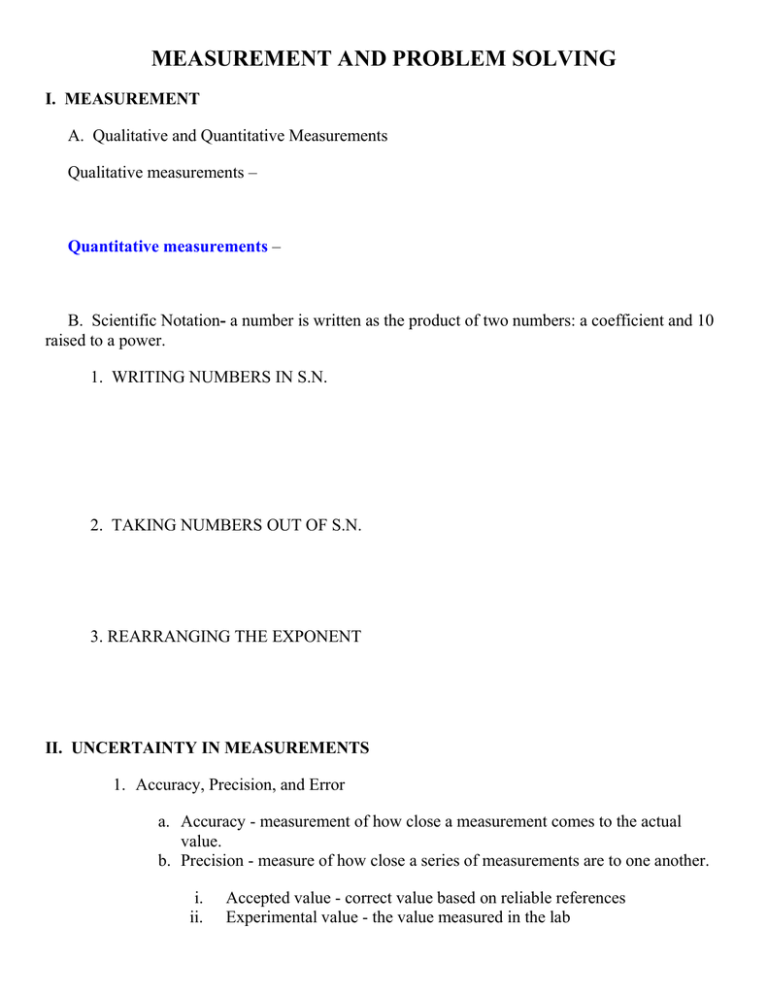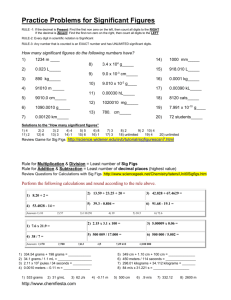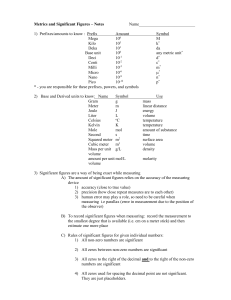
MEASUREMENT AND PROBLEM SOLVING
I. MEASUREMENT
A. Qualitative and Quantitative Measurements
Qualitative measurements –
Quantitative measurements –
B. Scientific Notation- a number is written as the product of two numbers: a coefficient and 10
raised to a power.
1. WRITING NUMBERS IN S.N.
2. TAKING NUMBERS OUT OF S.N.
3. REARRANGING THE EXPONENT
II. UNCERTAINTY IN MEASUREMENTS
1. Accuracy, Precision, and Error
a. Accuracy - measurement of how close a measurement comes to the actual
value.
b. Precision - measure of how close a series of measurements are to one another.
i.
ii.
Accepted value - correct value based on reliable references
Experimental value - the value measured in the lab
2. Per Cent Error – (accepted – experimental)/accepted x 100
A student experimentally determines the density of mercury to be 13.0 g/ml. Upon research they
find the value to be 13.36 g/mL. What is the percent error.
Significant Figures in Measurements - all the digits that are known , plus the last digit that is
estimated
3. Significant Number Rules (significant digits: sig digs)
1.
2.
3.
4.
5.
Every nonzero digit in a reported measurement is assumed to be significant.
Zeros appearing between nonzero digits are significant
Leftmost zeros appearing in front of nonzero digits are not significant.
Zeros at the end of a number and to the right of a decimal point are always significant.
Zeros at the rightmost end of a measurement that lie to the left of an understood decimal
point are not significant if they serve as placeholders to show the magnitude of the
number.
6. Two situations where measurements have unlimited number of Sig. Figs.
o Counting words
o Exactly defined quantities
Practice Sheet: underline the sig digs in each of the following & tell how many are there.
000001202 =
0.0004 =
0.0032402 =
1234.00 =
0.4560 =
6.0000 =
125600 cars
10.00 Liters
4. Rounding
Round the following to 3 sig figs:
123.56 = __________
0.004567=_______________
12.029 =___________
123456 =________________
5. Significant Figures in Calculations
In calculations involving multiplication and division, one needs to round the
answer to the same number of significant figures as the measurement with the
least number of significant figures.
The answer to an addition or subtraction calculation should be rounded to the
same number of decimal places (not digits) as the measurement with the least
number of decimal places.
Complete the indicated operation and provide the final answer with the
correct number of significant figures and proper units.
Problem
Calculator Answer
Rounded answer with units
.0100
How many sig OR places
behind the decimal
3 places
0.00598 mm + 0.004 mm
6.0930
1 sig fig
. 6 Kg
259130434.8
2 sig fig
26 (no units)
21.580
0 places
22L
.010 mm
79.6 mL + 0.0168 mL
27 L – 0.0838 L
420 cm – 19.11 cm
6.77 kg x 0.9 kg
16.2 mL x 23.79 mL
596,000 mg ÷ 0.0023 mg
56.200 g ÷ 260.5 g
23 L + 1.59 L – 3.01 L
21.4 km x 0.569 km ÷ 0.9 Km
III. INTERNATIONAL SYSTEM OF UNITS (SI) -Metric System
1. Units of Length In SI, basic unit of length is the meter (m).
2. Units of Volume
a. A Liter (L) is the volume of a cube that is 10 centimeters (cm) on each edge.
b. (10 cm * 10 cm* 10cm = 1000 cm3 = 1L).
c. A decimeter (dm) is equal to 10 cm, so: 1 L = 1 dm3
3. Units of Mass
a. Weight is a force that measures the pull on a given mass by gravity
b. Weight is different from mass, which is a measure of the quantity of matter.
c. The mass of an object is measured in comparison to a standard mass of 1
Kilogram (kg), which is the basic SI unit of mass.
d. A gram (g) is 1/1000 of a kilogram and is a more commonly used unit of mass
in chemistry.
4. Metric Prefixes: “walking in da metric hood”
There are many metric-unit prefixes, but the usual ones required in school are these: kilo-, hecto-, deka-, deci-, centi-, and
milli-. To convert between the various prefixes, and thus the variously-sized units, you just move up and down this list of
prefixes, moving the decimal point as you go.
To remember the prefixes in order, you can use the following sentence:
King Henry Doesn't [Usually] Drink Chocolate Milk
The first letters of the words stand for the prefixes, with "Usually" in the middle standing for the "unit", being meters,
grams, or liters. Many memory phrases omit the "Usually", and consequently students forget where the basic unit goes,
messing up their conversions. Leave the "Usually" in there so you can keep things straight:
kilo- hecto- deka- [unit] deci- centi- milli
Convert 12.54 kilometers to centimeters.
How many jumps is it from "kilo-" to "centi-"? Five, to the right.
So I move the decimal point five places to the right, filling in the extra space with zeroes:
Final Answer:______________________
Convert 457 mL to hL.
Copyright © Elizabeth Stapel 2006-2008 All Rights Reserved
How many jumps is it from "milli-" to "hecto-"? Five, to the left.
So I move the decimal point five places to the left, filling in the empty spots after the decimal point with zeroes:
Final Answer:___________________
Convert:
15.09 grams = __________kg=___________dKg
.00235 L = __________mL= _________kL
More Metric Conversions For Practice
1. Convert 12 m to cm.
2. Convert 5280 m to km.
3. Convert 112 cm to meters.
4. Convert 21,510 mL to liters.
5. Convert 129 mm to cm.
6. Convert 3.4 liters to mL.
7. Convert 1.4 km to cm.
8. Convert 7 days to minutes.
9. Convert 84 g to milligrams.
10. Convert 177 mm to meters.
IV. TEMPERATURE
1. Measuring Temperature
a. The temperature of an object determines the direction of heat transfer. (hotter
to less hot)
2. Temperature Scales
a. Temperature is measured on the Celsius and Kelvin scales
b. The Celsius Scale sets the freezing point of water at 0oC and the boiling point
at 100oC.
c. The zero point on the Kelvin scale, 0K, absolute zero = – 273.15 oC.
d. K= oC + 273 and oC = K - 273
V. HOW TO MAKE MEASUREMENTS IN LAB:
1. Determine the decimal value of the smallest line of measurement on the instrument.
2. Record your measurement to the next decimal place. THE LAST DIGIT
IN YOUR MEASUREMENT IS ALWAYS ESTIMATED.
3. Instruments to be used:
a. Mass- three or four beam balance
b. Volume-graduated cylinder, pipet, buret
c. Length-meter stick
4. Record the measurement for each of the following:
VI. PROBLEM SOLVING (FACTOR-LABEL METHOD)
The factor-label method was developed to keep track of units in multi-step conversion problems. In the
method, equalities (i.e., conversion factors) are set up in fraction form. The equalities are then lined up
sequentially and units used on the top and bottom of neighboring fractions are alternated so that units cancel.
For example, consider the conversion of inches to centimeters (1.00 in = 2.54 cm). How many centimeters are
in 5.00 inches?
For this problem, the following equalities exist:
All three are equivalent, but only the last has inches in the denominator. By choosing the last equality, we can
cancel units in the conversion.
Steps in the Conversion Factor Method
1.
2.
3.
4.
Write down the number and unit given.
Multiply by a conversion factor so that the units given cancel and the units desired are left.
Check the units. Cancel.
Calculate
Examples:
1. If a container of water absorbs 3.4 cal of heat, what is the amount of energy absorbed (in
joules)? 1 cal = 4.184 J
answer is rounded to two significant figures (RULES FOR
MULTIPLICATION)
2. Convert 65 miles/hour to meters/second. There are two different units in this problem. Treat them
separately. It does not matter which unit you solve first, as long as you complete its conversion before going to
the other. In the diagram below, the problem is solved with two conversion factors. However, if you don't know
how many seconds are in an hour or how many meters are in a mile, you can break them into relationships you
do know:
1 hour/60 minutes . . . 1 minute/60 seconds
5280 feet/1 mile . . . 12 inches/1 foot . . . 1 inch/2.54 centimeters . . . 100 centimeters/1 meter
Substitute and solve (use correct sig digs)
3. Manipulating area and volume units (i.e. m2 or cm3)
Convert: 1.25 km3 to in3
(1.25 km. km. km = ______ in. in. in)
English to Metric Conversions
Complete the following problems using the Factor Label Method. Show all work and circle
your final answer. Remember to include unitsand follow rules for sig digs in all of your answers.
Use the conversions listed below to help you.
Helpful Conversion Factors
2.54 cm = 1 inch
1 liter = 1.06 quarts
1 km = 0.62 miles 250 mL = 1 cup
1 kg = 2.2 pounds
28.3 g = 1 ounce
1. Kellog's Nutri Grain Bar (37 g). Convert to ounces.
2. Quaker Instant Oatmeal (15.1 oz). Convert to grams.
3. Old Orchard Apple Juice (355 mL). Convert to cups.
4. Old London Bread Crumbs (560 mg sodium). Convert to ounces.
5. Sprite (354 mL). Convert to quarts.
6. Reyonlds Wrap Aluminum Foil (22.8 m long). Convert to inches.
7. Life Cereal (15 oz). Convert to pounds.
8. Ground Beef Family Pack (3.25 pounds). Convert to kilograms.
9. Pepsi Bottle (2.0 L). Convert to cups.
10. Lay's Potato Chips (15 g fat). Convert to ounces.
REAL PROBLEMS (TIME TO STEP UP!!)
(hint: highlight the ratio(s) first)
1. A track athlete runs a mile in 3 minutes 53.6 seconds. At this rate how many seconds will it
Take him to run 750 meters?
2. A country has stockpiles 85,000 tons of gold. If gold is currently selling at $560.00 per
ounce, what is the total worth of this gold?
3. A sheet of aluminum foil has a total area of 1.00 ft2. The section of foil has a mass of
3.35 grams. If the density of the foil is 2.70 g/cm3, how thick is the foil in mm.
Volume = l x w x h =Area x h
4. If the diameter of an aluminum atom is 2.5 x 10-12 m, how many atoms thick is the foil?
5. The normal lead content a sample of tissue is .40 ppm (parts of lead/million parts of tissue).
How many grams of lead would be expected to be found in a 150 pound adult?
6. How many years are in 15.00 seconds?
7. One mole of water has a mass of 18.02 grams and contains 6.023x1023 molecules.
Water molecules have a chemical ratio H2O How many oxygen atoms are in 1.00 g of water?
8. It is estimated that our atmosphere contains 9.4 x 1022 g of nitrogen. The atmosphere is
approximately 78% nitrogen by weight. What is the weight of our atmosphere in tons?
9. The surface area and average depth of pacific ocean is 1.8 x 108 km2 and 3900 m
respectively. The average density of the ocean is 1.2 g/cm3, what is the mass of the
Ocean in kilograms?
10. Vanillin is a substance whose aroma the nose can detect in a concentration of 2x10 -11 g/L.
Pure vanillin cost $75.00/g. If our classroom is 34.2 ft x 48.2 ft x 8.25 ft, what would be
The cost of vanillin required to produce the slightest aroma throughout our classroom.




